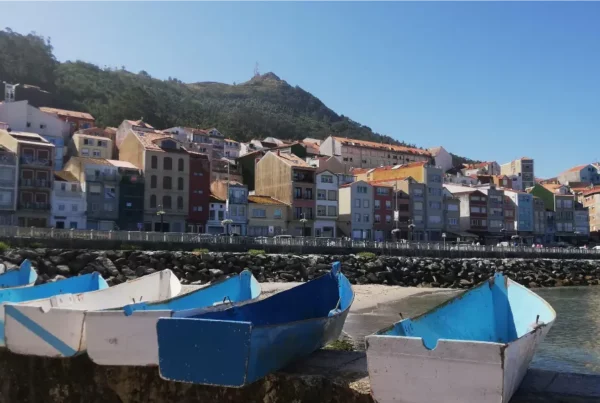Every year, hundreds of thousands of pilgrims follow the ancient trails of the Camino de Santiago, often ending in the iconic city of Santiago de Compostela. But how did this small Galician city become one of the most important pilgrimage destinations in Europe?
In this article, we explore the historical foundations of Santiago de Compostela, uncovering the legends, milestones, and cultural elements that have shaped its unique identity along routes such as the Portuguese Coastal Way.
The Origins: Who Was Santiago?
- Santiago (Saint James the Greater) was one of the twelve apostles of Jesus.
- Tradition holds that after his martyrdom in Jerusalem, his remains were miraculously transported to the Iberian Peninsula.
- His body was said to be buried in a forgotten tomb in Galicia, lost for centuries.
This narrative forms the spiritual backbone of what would later become Santiago de Compostela, with “Santiago” referring to Saint James, and “Compostela” believed to come from campus stellae, or “field of stars.”
The Discovery of the Tomb: Birth of a Pilgrimage
In the early 9th century, a hermit named Pelayo observed mysterious lights in a forest near Iria Flavia. He alerted the local bishop, Theodomir, who investigated and uncovered what was believed to be the tomb of the apostle.
This event, dated to 813 AD, sparked the beginning of the Santiago de Compostela pilgrimage, attracting Christian faithful from across medieval Europe. It became one of the most important religious routes, alongside Jerusalem and Rome.
5 Key Historical Milestones That Made Santiago Famous
- Religious Recognition
In 1075, construction began on the Romanesque cathedral of Santiago, a symbol of the Christian Reconquest and pilgrimage culture. - Papal Indulgences
The Church granted plenary indulgences to pilgrims visiting Santiago during Holy Years, increasing its religious status. - The Codex Calixtinus (12th century)
This medieval manuscript functioned as the first “pilgrim’s guide,” detailing the route, customs, and miracles associated with Saint James. - Pilgrimage Infrastructure
The growing flow of pilgrims led to the creation of hospices, hospitals, and safe pathways. Even today, the network of albergues and services reflect this legacy. - UNESCO World Heritage Status
The historic center of Santiago and major pilgrimage routes were designated World Heritage Sites in the 1980s and 1990s, protecting their cultural significance.
Santiago and the Camino During the Middle Ages
By the 12th century, the pilgrimage to Santiago de Compostela had become a Europe-wide phenomenon. Monarchs, nobles, peasants, and clergy made the journey, often as penance or spiritual renewal. Roads leading to Santiago formed what became known as the Camino de Santiago network.
Pilgrims were guided by the scallop shell, the now-famous symbol of the journey. The shell not only served as a physical marker but also represented the spiritual reward waiting at the end.
The Portuguese Coastal Way: A Historical Route Gaining Popularity
Among the many routes to Santiago, the Portuguese Coastal Way is one of the oldest and most scenic. Historical records show that pilgrims from Portugal have walked along the Atlantic coastline since the Middle Ages, visiting key cities like Porto, Viana do Castelo, and A Guarda before reaching Santiago.
In recent years, the Portuguese Coastal Way has seen rapid growth. According to official statistics, it has quadrupled in popularity over the past five years, becoming a preferred choice for international pilgrims seeking quieter, nature-rich paths.
Want to explore this path in depth? Read our complete guide to the Portuguese Camino by the Coast.
5 Fascinating Facts About Santiago de Compostela
Fact 1: The Botafumeiro
The giant incense burner in the cathedral weighs over 50kg and swings across the transept during special pilgrim masses.
Fact 2: Pilgrimage Credentials and the Compostela
Pilgrims collect stamps along their journey. Upon arrival, they present this document at the Pilgrim’s Office to receive the Compostela certificate.
Fact 3: The Cathedral’s Architectural Mix
Originally Romanesque, the Cathedral features Gothic, Baroque, and Neoclassical additions, reflecting centuries of evolution.
Fact 4: Pilgrimage in Numbers
In 2023, more than 446,000 Compostelas were issued, with growing numbers from the US, Germany, Italy, and Portugal.
Fact 5: The Obradoiro Square
The square in front of the cathedral has been the emotional finish line for pilgrims for over 1,000 years.
Common Questions About Santiago de Compostela
Is Santiago de Compostela only for religious pilgrims?
No. While historically religious, modern pilgrims include people seeking cultural, spiritual, or personal growth experiences.
What does “Compostela” mean?
Most scholars agree it derives from Latin, meaning “field of stars” — a reference to the star that guided Pelayo to the tomb.
Do I need to walk the full Camino to get the Compostela?
Pilgrims must walk at least 100 km (or cycle 200 km) and collect stamps in a credential to receive the certificate.
Conclusion: Why Understanding Santiago’s History Enriches Your Journey
Whether you’re walking for faith, fitness, or curiosity, arriving in Santiago de Compostela carries centuries of human meaning. It connects you to a shared European heritage, one built on roads, resilience, and reverence.
Understanding this history deepens every step you take, especially if you’re following the Portuguese Coastal Way, where ocean views meet spiritual reflection.
For practical advice, check out our Camino de Santiago packing list and start preparing today.






